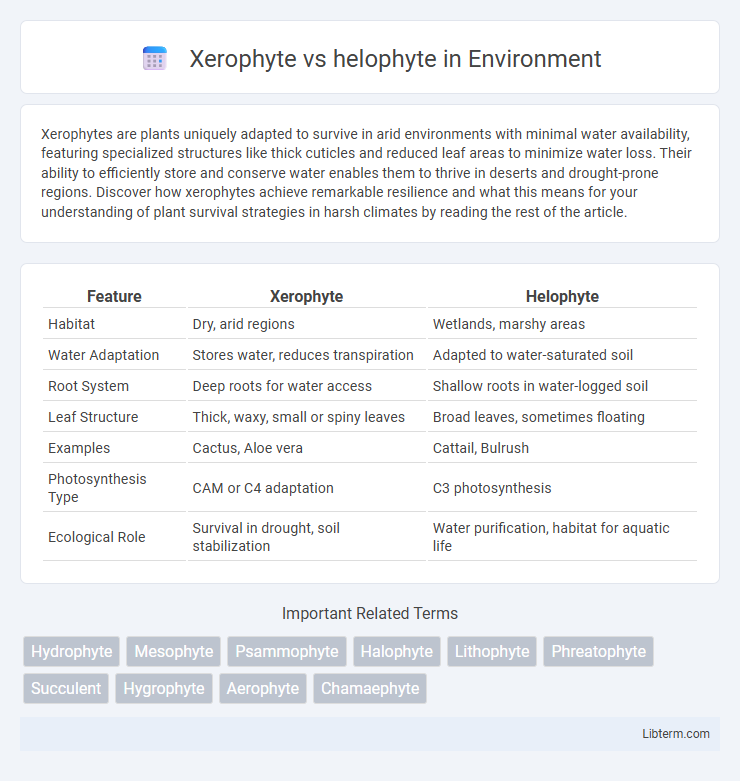Xerophytes are plants uniquely adapted to survive in arid environments with minimal water availability, featuring specialized structures like thick cuticles and reduced leaf areas to minimize water loss. Their ability to efficiently store and conserve water enables them to thrive in deserts and drought-prone regions. Discover how xerophytes achieve remarkable resilience and what this means for your understanding of plant survival strategies in harsh climates by reading the rest of the article.
Table of Comparison
| Feature | Xerophyte | Helophyte |
|---|---|---|
| Habitat | Dry, arid regions | Wetlands, marshy areas |
| Water Adaptation | Stores water, reduces transpiration | Adapted to water-saturated soil |
| Root System | Deep roots for water access | Shallow roots in water-logged soil |
| Leaf Structure | Thick, waxy, small or spiny leaves | Broad leaves, sometimes floating |
| Examples | Cactus, Aloe vera | Cattail, Bulrush |
| Photosynthesis Type | CAM or C4 adaptation | C3 photosynthesis |
| Ecological Role | Survival in drought, soil stabilization | Water purification, habitat for aquatic life |
Introduction to Xerophytes and Helophytes
Xerophytes are plants adapted to survive in arid environments with minimal water availability, often exhibiting features like thick cuticles, reduced leaf areas, and deep root systems to conserve moisture. Helophytes, in contrast, thrive in wetland habitats where they are partially submerged or rooted in waterlogged soils, showing adaptations such as aerenchyma tissue for oxygen transport and flexible stems to withstand water currents. Both xerophytes and helophytes demonstrate specialized structural and physiological traits that enable them to efficiently utilize and manage water resources in their contrasting ecosystems.
Defining Xerophytes: Key Characteristics
Xerophytes are plants adapted to survive in arid environments with minimal water availability, exhibiting characteristics such as thick, waxy cuticles, reduced leaf surface area, and deep root systems to conserve moisture. These plants utilize specialized physiological mechanisms like CAM photosynthesis to reduce water loss and maintain metabolic function during drought. In contrast to helophytes, which thrive in water-saturated soils, xerophytes display structural and biochemical adaptations that optimize water retention and drought resistance.
Understanding Helophytes: Essential Features
Helophytes are aquatic plants adapted to waterlogged conditions, characterized by extensive rhizome systems and aerenchyma tissue that facilitates oxygen transport in submerged environments. These plants thrive in marshes, swamps, and shallow water bodies, playing a crucial role in wetland ecosystems by stabilizing soil and filtering pollutants. Unlike xerophytes, which are drought-resistant and adapted to arid environments, helophytes require constant moisture and are integral to maintaining biodiversity in freshwater habitats.
Habitat Differences: Drylands vs Wetlands
Xerophytes thrive in arid drylands, exhibiting adaptations such as thick cuticles and reduced leaf surfaces to conserve water in desert and semi-desert environments. Helophytes occupy wetlands and marshy areas, where roots are submerged in waterlogged soils and plants develop aerenchyma tissues for oxygen transport in saturated conditions. Habitat differences dictate distinct physiological and morphological traits that enable xerophytes to withstand drought and helophytes to tolerate water saturation.
Morphological Adaptations in Xerophytes
Xerophytes exhibit specialized morphological adaptations such as thickened cuticles, reduced leaf surface area, and sunken stomata to minimize water loss in arid environments. Their extensive root systems enhance water absorption from deep or scarce sources, while succulent tissues store water efficiently. These features contrast with helophytes, which possess adaptations suited for waterlogged soils, such as aerenchyma for oxygen transport.
Structural Adaptations in Helophytes
Helophytes exhibit specialized structural adaptations such as aerenchyma tissue that facilitates oxygen transport to submerged roots and rhizomes, enabling survival in waterlogged environments. Their elongated stems and leaves often contain air spaces for buoyancy and gas exchange. These features contrast with xerophytes, which have thick cuticles and reduced leaf surfaces to minimize water loss in arid conditions.
Physiological Mechanisms for Survival
Xerophytes possess specialized physiological mechanisms such as Crassulacean Acid Metabolism (CAM) and extensive cuticular wax to minimize water loss, enabling survival in arid environments. Helophytes utilize efficient internal aeration systems like aerenchyma tissues to facilitate oxygen transport in waterlogged soils, preventing root anoxia. Both plant types optimize resource use through adaptations: xerophytes prioritize water conservation, whereas helophytes enhance oxygen availability in saturated conditions.
Ecological Roles of Xerophytes and Helophytes
Xerophytes play a crucial ecological role by stabilizing arid and semi-arid ecosystems, conserving soil moisture, and providing habitat for drought-adapted fauna. Helophytes contribute significantly to wetland ecosystems by improving water quality through nutrient uptake, supporting diverse aquatic species, and enhancing sediment stabilization. Both plant types are integral to their respective environments, promoting biodiversity and ecosystem resilience under extreme water availability conditions.
Examples of Xerophyte and Helophyte Species
Xerophyte species such as cacti (e.g., Carnegiea gigantea), agaves (Agave americana), and succulents exhibit adaptations to survive in arid environments by conserving water. Helophyte species including cattails (Typha latifolia), bulrushes (Schoenoplectus spp.), and sedges (Carex spp.) thrive in wetland habitats with water-saturated soils. These plant groups represent ecological specializations for drought tolerance in xerophytes and waterlogged conditions in helophytes.
Xerophyte vs Helophyte: Key Differences and Similarities
Xerophytes thrive in arid environments by adapting to conserve water through features like thick cuticles, reduced leaf surface area, and deep root systems, whereas helophytes are specialized to grow in waterlogged soils and marshy conditions, often exhibiting aerenchyma tissues for oxygen transport. Both plant types demonstrate unique physiological and structural adaptations that enable survival in extreme moisture conditions, but xerophytes emphasize drought resistance while helophytes focus on coping with excess water. Understanding these adaptations highlights the ecological roles and habitat-specific survival strategies of xerophytes and helophytes.
Xerophyte Infographic

 libterm.com
libterm.com